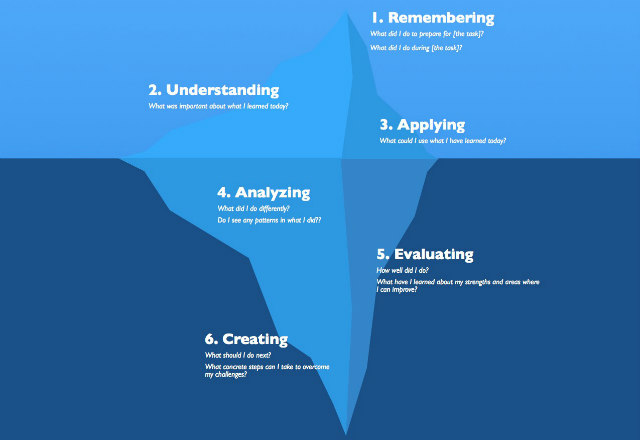Educators have long recognized the importance and applicability of critical reflection across a wide range of educational settings, yet in practice it remains a challenging and nebulous concept for many to firmly grasp. In education, the concept of reflection dates back to the work of John Dewey (1933), who defined it as “active, persistent and careful consideration of any belief or supposed form of knowledge in the light of the grounds that support it and the further conclusion to which it tends” (p. 9). Dewey was the first to point out that experience alone does not constitute learning; instead, a conscious realization must occur for the experience to become a source of learning.
In examining the depth of reflection, Rogers (2001) made an influential and careful study and synthesis, while Peltier, Hay, and Drago (2005) put forward a way to evaluate different levels of reflective thinking, which include habitual actions, understanding, reflection, and critical reflection (refer to Weimer, 2012). Yet the void of ecologically valid classroom-based research on incorporating reflection to improve student learning has left teachers largely on their own when it comes to creating opportunities for reflection in their courses.
Reflection is, however, intrinsically linked to metacognition and self-regulation, where there is ample evidence as to their importance to learning (e.g., Bartimote-Aufflick, Bridgeman, Walker, Sharma, & Smith, 2016; Chen, Chavez, Ong, & Gunderson, 2017; Lang, 2012). Through reflection, learners develop their ability to integrate the insights they gain into their learning/life experience so that they can make better choices and improve their learning (Rogers, 2001). The end goal, self-regulated learning, as defined by Hadwin (2008), involves “the deliberate planning, monitoring and regulating of cognitive, behavioral and affective or motivational processes towards completion of an academic task” (p. 179).
Overcoming student resistance
As educators, many of us have probably been asked to reflect in writing on our learning experiences or have asked our students to engage in written reflection. Reflection has been one of the most commonly used pedagogical tools by teachers and teacher-educators across a wide variety of disciplines ever since the ancient Greek philosophers first identified it as a way of learning. Yet anyone who has attempted to implement reflection in his or her teaching will have encountered learner resistance.
Prior to a reflection task, I have often asked my students to candidly share their thoughts about engaging in reflection. While few are naturally reflective or drawn to such thinking processes, most learners have expressed that they feel genuinely uncomfortable talking about themselves and/or are reflecting simply to fulfill an assigned task. Some also confess that they are inclined to overstate their learning in order to cast a positive light on what they got out of a particular learning episode. In most cases, learners rarely move beyond the tip of the iceberg; instead they tend simply to describe habitual activities or what they did in a task or course. This is also common across disciplines, more perceptible in some than in others.
Presented here are three simple ideas you might like to consider that have worked well for me during my years of researching learner reflection and integrating it into my classrooms. Hopefully they may prompt your students to move beyond surface-level “reflection” to a position where they don’t consider integrating the reflection component a waste of time.
1. Begin reflection where the learners are. Have a quick open discussion to clarify assumptions and expectations about how learners perceive reflection so that you can minimize a likely potential mismatch between your expectations and your students’ preconceived notions about what engaging in reflection entails. If you intend to encourage your students to engage in regular reflection, their first few entries will usually provide some clues about their individual depth of reflection. Make use of their experiences in the learning process to help them anticipate the reflective process and see the benefits of reflection beyond learning; this can encourage openness and engagement in the reflection task. Remember that reflection tasks do not have to be onerous (Anderson, 2017)—attend to individual needs and preferences (see points 2 and 3) and make them manageable (e.g., assign shorter tasks, with guidance if needed), goal specific (i.e., focus on the purpose of the reflection), and time-based (i.e., ensure a narrow time lapse between the event and the reflection) for optimal reflection.
2. Provide scaffolding to suit your learners’ reflective continuum. Some of your students will naturally be more adept than others at engaging in reflection. For those who need some guidance, use a few guiding questions drawing on the 5 Rs: recalling (e.g., recalling an episode/event), recapturing (e.g., capturing the emotions, accomplishments, and challenges), relating (e.g., relating what was recalled to previous personal experiences), rationalizing (e.g., understanding the patterns or learning from experiences to create meaning from past events), and redirecting (e.g., engaging in purposeful thinking directed towards future actions).
Alternatively, I have used in my teaching and research the following simple figure, which builds on the revised Bloom’s taxonomy (Anderson et al., 2013) to help learners explore beyond the tip of the iceberg and develop depth of reflection. Having learners use their first reflective entry to analyze the level(s) of reflection they engaged in, using either method, is also a great awareness-raising activity.

3. Give learners the freedom to experiment with different modalities of reflection. Over the years, I have received some of the most amazingly thoughtful and critical reflections from learners who used mediational means other than writing. Be open to other modalities of reflection; my students’ audio recordings of individual or pair/triadic spoken reflections, video recordings of individual or pair/triadic spoken reflections, and video-stimulated individual or pair reflections (i.e., videotaping an activity and then replaying the recording as a stimulus to elicit thoughts regarding the task performance) have led to some of the most moving, memorable, and insightful personal discoveries.
Alternative modalities have provided my students distinct dialogical pathways to thoughts and feelings that might have been difficult to identify via the traditional means of individual written reflection. The commonly held perception that reflection must be done in solitude or in writing merits reconsideration. Over the past nearly two decades, I have discovered there is no single path for learners and instructors to achieving the goal of reflective learning. The process of reflection must take account of individual preferences and affective variables.
Reflecting on our own thoughts is an integral part of human existence, but the inductive nature of reflection means that the outcomes of learning through reflection are often not immediately discernable to learners. Critical reflection takes time and much hard work, but seeking methods that foster learning how to learn through reflection is key to self-regulated learning. As Rogers (2001) once said: “Perhaps no other concept offers . . . as much potential for engendering lasting and effective change in the lives of students as that of reflection” (p. 55).
References
Anderson, J. (2017). A Stanford researcher’s 15-minute study hack lifts B+ students into the As. Quartz. Retrieved from https://qz.com/978273
Anderson, L. W., Krathwohl, D. R., Airasian, P., Cruikshank, K. A., Mayer, R. E., Pintrich, P. R., . . . & Wittrock, M. C. (2013). A taxonomy for learning, teaching, and assessing: A revision of Bloom’s taxonomy of educational objectives (abridged edition). Harlow, UK: Pearson Education.
Bartimote-Afflick, K., Bridgeman, A., Walker, R., Sharma, M., & Smith, L. (2016). The study, evaluation, and improvement of university student self-efficacy. Studies in Higher Education, 41(11), 1918–1942.
Chen, P., Chavez, O., Ong, D. C., & Gunderson, B. (2017). Strategic resource use for learning: A self-administered intervention that guides self-reflection on effective resource use enhances academic performance. Psychology Science, 28(6), 774–785.
Dewey, J. (1933). How we think: A restatement of the relation of reflective thinking to the education process. Boston, MA: D. C. Heath.
Hadwin, A. F. (2008). Self-regulated learning. In T. L. Good (Ed.), 21st century education: A reference handbook (pp. 175–183). Thousand Oaks, CA: Sage.
Lang, J. M. (2012, January 17). Metacognition and student learning. The Chronicle of Higher Education. Retrieved from http://goo.gl/sclBC
Peltier, J. W., Hay, A., & Drago, W. (2005). The reflective learning continuum: Reflection on reflection. Journal of Marketing Education, 27, 250–263.
Rogers, R. R. (2001). Reflection in higher education: A concept analysis. Innovative Higher Education, 26(1), 37–57.
Weimer, M. (2012). Four levels of student reflection. Faculty Focus. Retrieved from https://www.facultyfocus.com/?p=31829
Dr. Li-Shih Huang, Associate Professor of Applied Linguistics, Department of Linguistics, University of Victoria, BC, Canada. She is also the recipient of the 2014 Humanities Teaching Excellence Award.






